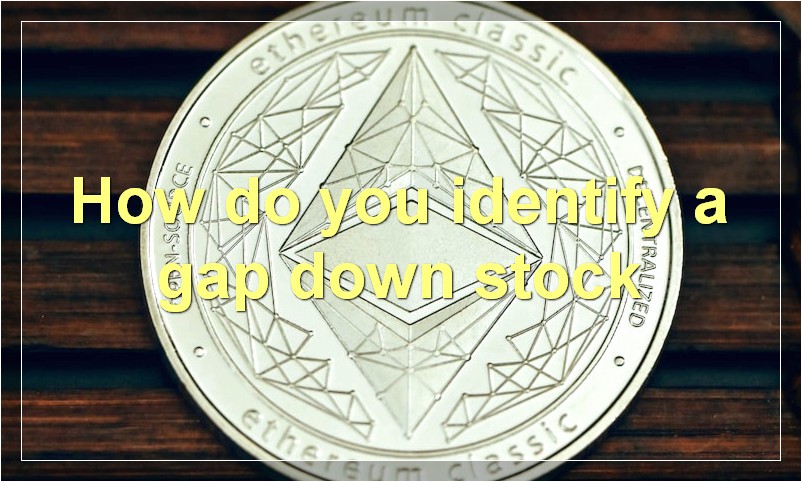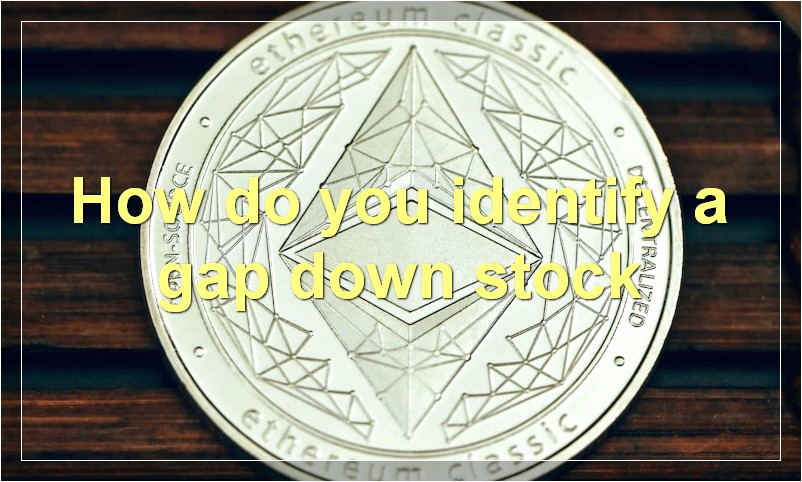If you don’t know what a gap down stock is, you’re not alone. Many investors don’t fully understand this concept, which can lead to big losses.
What is a gap down stock
When it comes to investing in the stock market, there are a lot of terms and phrases that can be confusing for newcomers. One phrase you may have come across is “gap down.” So, what is a gap down stock?
A gap down stock is a stock that opens at a lower price than it closed at the previous day. This can be caused by a number of factors, such as poor earnings reports or negative news about the company.
Gap down stocks can be risky investments, because they often indicate that there is something wrong with the company. However, they can also present an opportunity for savvy investors to buy shares at a discount.
If you’re thinking of investing in a gap down stock, it’s important to do your research and understand the risks involved. But if you’re willing to take on some risk, a gap down stock could be a great investment opportunity.
How do you identify a gap down stock

A gap down stock is a stock that opens at a lower price than it closed at the previous day. This indicates that there is selling pressure in the market for that stock. There are a few ways to identify a gap down stock:
-Check the stock charts: A gap down will be visible as a sharp drop in the price at the start of the trading day.
-Look for news: A company may issue a press release before the market opens if there is bad news that is likely to cause the stock price to gap down.
-Monitor the market: If the overall market is weak, then it is more likely that individual stocks will gap down.
What are the characteristics of a gap down stock
A gap down stock is a stock that opens at a lower price than the previous day’s close. This type of stock is often seen during periods of market weakness, as investors are selling off their holdings. Gap down stocks can be volatile and may continue to fall in price, or they may recover and move higher.
Why do stocks sometimes gap down
When a company releases earnings that are below expectations, its stock might “gap down.” This means the stock opens at a lower price than it closed at the day before. There are a few reasons why this might happen:
1. The market was overreacting to the news.
2. Sellers were trying to unload the stock before it fell any further.
3. Buyers thought they could get a bargain and snapped up shares.
Whatever the reason, a gap down can be an opportunity for savvy investors to buy shares on the cheap. Just make sure you do your homework first to ensure the stock is still a good investment despite the bad news.
What news or events can cause a stock to gap down
When a company releases earnings that are below expectations, the stock may gap down. This is because investors had hoped for better results and are disappointed with the actual results. If a company misses earnings estimates by a wide margin, the stock may gap down even more. Other news or events that can cause a stock to gap down include guidance that is below expectations, FDA approval delays, and bad news about a product.
How do investors react to a stock that gaps down

When a stock gaps down, it can be a concerning sight for investors. After all, it typically means that the stock has lost value and is now trading at a lower price than where it had previously been. However, it’s important to remember that not all stocks that gap down are created equal. In some cases, a stock may gap down due to bad news, such as a poor earnings report. In other cases, the stock may have simply been oversold and is now rebounding. As an investor, it’s important to take a closer look at the underlying reason for the gap before making any decisions.
If a stock gaps down due to bad news, then it’s likely that the sell-off is warranted and the stock may not be a good investment at this time. On the other hand, if a stock gaps down due to being oversold, then it may be worth considering as a potential investment. Of course, there are other factors to consider as well, but this is a general overview of how investors may react to a stock that gaps down.
Should you buy a stock that gaps down
A gap down is when a stock opens lower than it closed the previous day. Gaps can be caused by a number of factors, including earnings releases, analyst upgrades or downgrades, news events, and even rumors.
If you’re looking at a stock that gaps down, there are a few things you need to consider before making a decision to buy.
First, what caused the gap? If it was due to bad news, then you need to decide if the news is likely to have a lasting impact on the company’s business. If it’s a one-time event, then the stock may be a bargain.
Second, how did the market react to the news? If there was a lot of selling pressure and the stock dropped significantly, then it may be best to wait for things to settle down before buying.
Third, what’s your timeframe? If you’re looking to buy and hold for the long term, then a gap down may not matter as much. But if you’re planning on selling soon, then you’ll need to factor in how long it will take for the stock to recover from its drop.
In general, you should only buy a stock that gaps down if you’re comfortable with the risks and have a plan for how you’ll exit your position if things don’t go as planned.
What are the risks of buying a stock that gaps down
There are a few risks to take into consideration when buying a stock that gaps down. The first is that the company may be in trouble and the stock price is dropping as a result. This could indicate that the company is about to go bankrupt or is otherwise in financial trouble. If this is the case, you could lose all of your investment.
Another risk is that the gap down could be a sign that the market is about to crash. If you buy a stock just before a market crash, you could see the value of your investment drop significantly.
Finally, it’s important to remember that stocks are volatile and can gap up or down at any time for any reason. This means that even if a stock looks like a good deal, there’s always the potential for it to drop in value suddenly. You should only invest money that you’re comfortable losing in order to reduce your risk.
How can you profit from a gap down stock
When a stock gaps down, it means the stock price opened lower than it closed the previous day. This usually happens because of some bad news that came out after the market closed. For example, if a company announces poor earnings results after the market closes, you might see the stock gap down when the market opens the next day.
If you’re quick on your feet, you can profit from a gap down stock by buying it as soon as the market opens. The reason is that gap downs are often overdone. Investors tend to sell first and ask questions later when they see a stockgap down. This selling pressure can drive the stock price even lower, giving you a chance to buy it at a discount.
Of course, you need to be careful. Not all gap downs are created equal. You need to do your homework to make sure the stock is still a good investment despite the bad news. And you need to be prepared to take a loss if the stock continues to fall. But if you’re brave and smart, you can make some money when everyone else is running for the exits.
What are some strategies for trading gap down stocks
When a stock gaps down, it can be a difficult decision for traders on how to approach the situation. There are a few different strategies that can be used when trading gap down stocks. One strategy is to wait for the stock to fill the gap. This means that the stock will rise back up to the price it was at before it gaps down. Another strategy is to buy when the stock starts to bounce off of the support level. This is when the stock price starts to increase after hitting a low point. The last strategy is to short the stock. This means that you think the stock will continue to go down and you will make money if it does.

